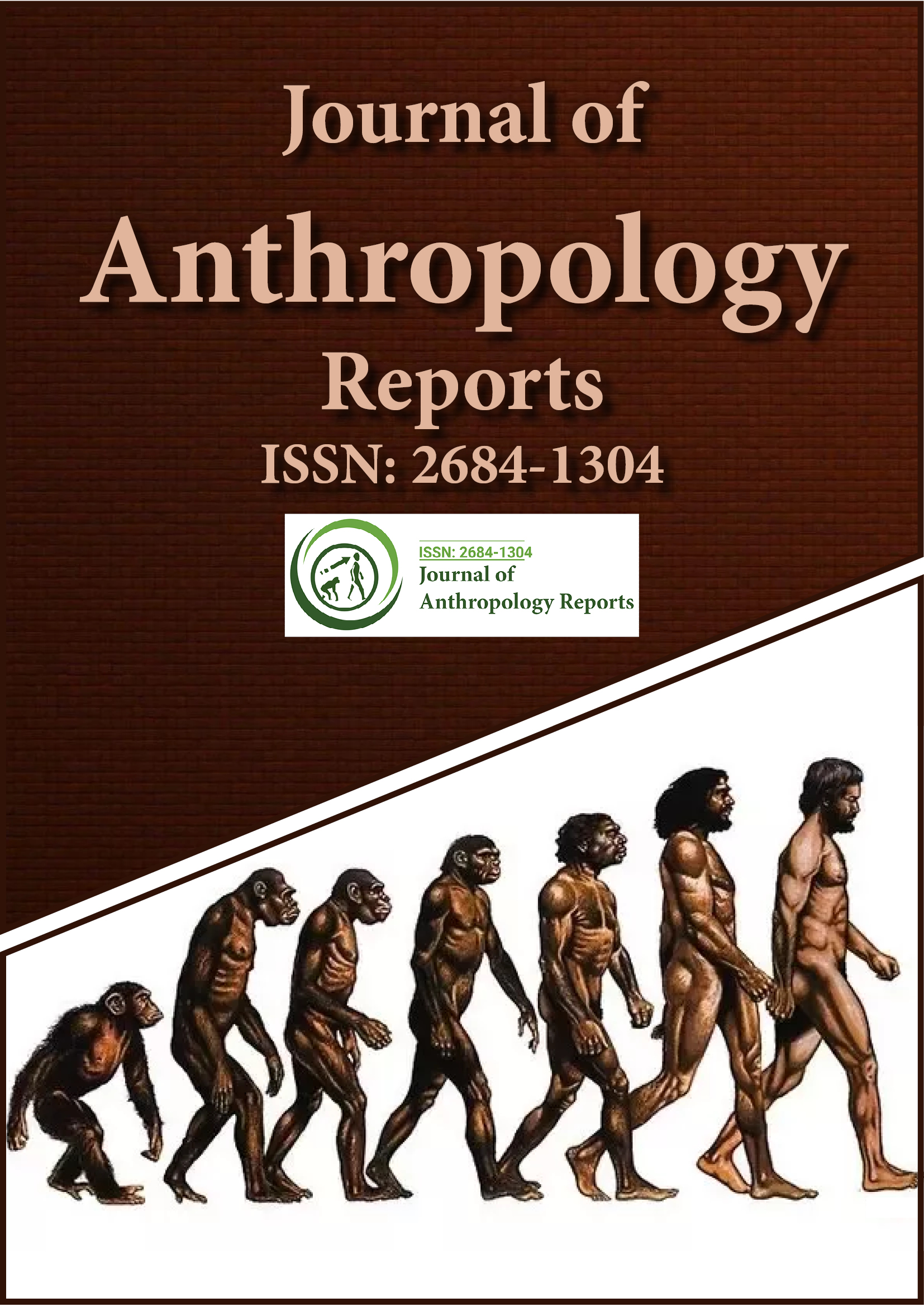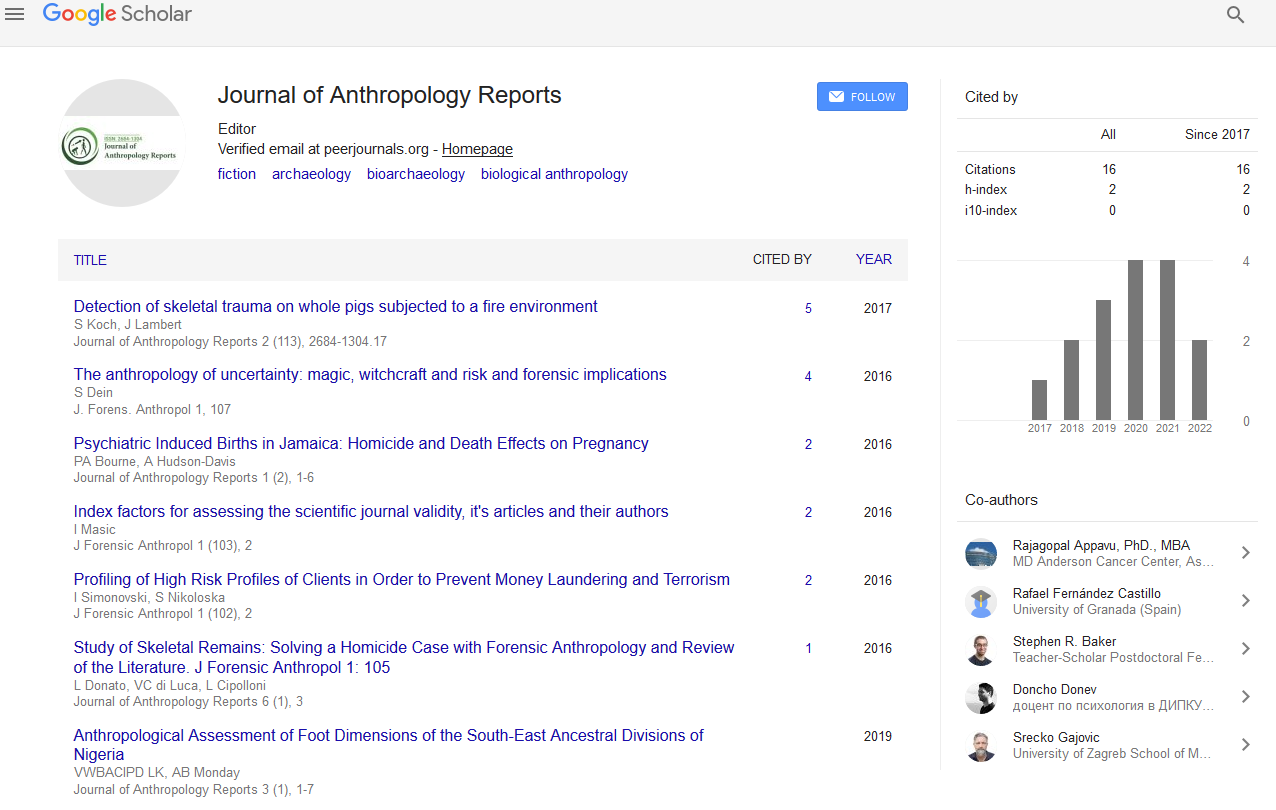Indexed In
- RefSeek
- Hamdard University
- EBSCO A-Z
Useful Links
Share This Page
Journal Flyer

Open Access Journals
- Agri and Aquaculture
- Biochemistry
- Bioinformatics & Systems Biology
- Business & Management
- Chemistry
- Clinical Sciences
- Engineering
- Food & Nutrition
- General Science
- Genetics & Molecular Biology
- Immunology & Microbiology
- Medical Sciences
- Neuroscience & Psychology
- Nursing & Health Care
- Pharmaceutical Sciences
Commentary - (2023) Volume 6, Issue 4
Exploring Human Evolution: An Overview of Palaeoanthropology
William C. Foley*Received: 04-Dec-2023, Manuscript No. JFA-24-24559; Editor assigned: 06-Dec-2023, Pre QC No. JFA-24-24559 (PQ); Reviewed: 20-Dec-2023, QC No. JFA-24-24559 (QC); Revised: 27-Dec-2023, Manuscript No. JFA-24-24559 (R); Published: 04-Jan-2024, DOI: 10.35248/2684-1304.24.6.177
Description
Paleoanthropology surfaced as a wisdom during the late nineteenth century. The discovery of Neolithic vestiges in Pleistocene deposits soon led to the excavation of fossilized mortal bones. The archaeologists and geologists who exhumed these vestiges were primarily concerned with determining whether the mortal fuds and the vestiges set up by them actually dated from the Pleistocene, therefore offering substantiation for the geological age of humans. The term paleoanthropology derives from Greek palsies “old, ancient”, Anthropology “man, mortal” and the suffix-logistics “study of”. Louis Lartet was one of the first to use the term “paleo-anthropology.” Paleoanthropology surfaced within the environment of the growing archaeological substantiation from the late 1850s and early 1860s for the presence of humans in Europe during the Pleistocene therefore as the name indicates, Palaeoanthropology is the study of man of ancient times. Now how do we study ancient man in current times, its elaboration through the fuds of our early ancestors. Now what are fuds? It’s a Latin word “Fodre” which means discover historical artifacts and landmarks. Paleoanthropology is generally considered as the study of mortal funds and a descriptive and astronomically narrative discipline that's dominated by inadequately delved and media-friendly “findings” that bring about the changing views on the process of mortal elaboration. Moment’s paleoanthropology or mortal planetology is a sub discipline of evolutionary biology that aims to describe, dissect, and interpret the process of mortal elaboration substantially through a set of inductive approaches and deducible thesis testing. The paleoanthropological approach helps to reconstruct our evolutionary history from the recovery and analysis of any applicable reactionary substantiation. Current paleoanthropological exploration doesn't only ask what our forerunners looked like and when, where, and how they evolved but also specifically asks, for illustration, why humans evolved while other primate species failed out. In paleoanthropology- as in other life lore’s with a chronological perspective-the trial is the literal process of nature itself.
To adequately understand mortal bio-cultural elaboration, we need a broad base of information. Paleoanthropologists recover and interpret all the suggestions left by early hominins. It's a different multidisciplinary pursuit that seeks to reconstruct every possible bit of information concerning the courting, deconstruction and ecology of our hominin ancestors. In the once many decades, the study of early hominins has marshalled the technical chops of numerous different kinds of scientists. This growing and instigative adventure includes, but isn't limited to, geologists, invertebrate paleontologists, archaeologists, physical anthropologists and paleoecologists. Geologists, generally working with other paleoanthropologists, do the original check to detect implicit early hominin spots. numerous sophisticated ways can contribute to this hunt, including upstanding and satellite photography. Invertebrate paleontologists are also involved in this early check work, for they can help find geological beds containing faunal remains where conditions are favourable for the preservation of bone from similar species as ancient gormandizers or baboons, conditions may also be favourable for the preservation of hominin fuds. Paleontologists can also (through comparison with known faunal sequences) give quick and approximate periods of reactionary spots in the field without having to stay for the precious and time- consuming chronometric analyses. Once linked, reactionary beds likely to contain hominin discoveries come the focus for farther expansive surveying. For some spots, generally those succeeding 2.6 mya (the age of the oldest linked mortal vestiges), archaeologists take over in the hunt for hominin material traces. We do not inescapably have to find remains of early hominins themselves to know that they constantly enthralled a particular area. similar material suggestions as vestiges inform us directly about early hominin conditioning. Modifying jewels according to a harmonious plan or simply carrying them around from one place to another over fairly long distances (In a manner not fluently explained by natural means, like brume or glaciers is characteristic of no other beast but hominins. We've learnt that Palaeoanthropology being an offshoot of anthropology and archaeology focuses on the reconstructing the ultramodern human on evolutionary lines working on natural pointers e.g. petrified cadaverous remains, bone fractions, vestiges and artistic information as gravestone tools, vestiges, and agreement points. With similar broad diapason of this branch, palaeoanthropology is astronomically of significance in educating about our history and that of nature and profitable operations.
Citation: Foley WC (2024) Exploring Human Evolution: An Overview of Palaeoanthropology. J Anthropol Rep. 6:177.
Copyright: © 2024 Foley WC. This is an open-access article distributed under the terms of the Creative Commons Attribution License, which permits unrestricted use, distribution, and reproduction in any medium, provided the original author and source are credited.

